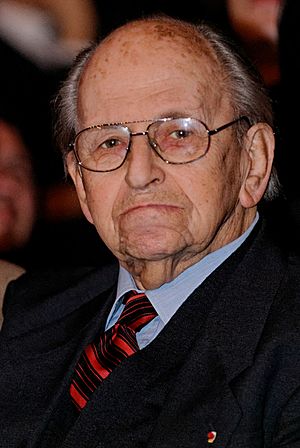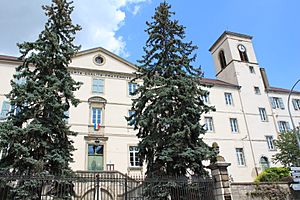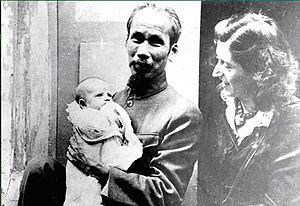Raymond Aubrac facts for kids
Quick facts for kids
Raymond Aubrac
|
|
|---|---|

Aubrac in 2008
|
|
| Born | 31 July 1914 Vesoul, France
|
| Died | 10 April 2012 (aged 97) Paris, France
|
| Nationality | French |
| Education | Lycée Saint-Louis |
| Alma mater | École nationale des ponts et chaussées Harvard University Massachusetts Institute of Technology |
| Occupation | French Resistance leader, civil engineer |
| Spouse(s) | |
| Children | three (son Jean-Pierre, daughters Catherine and Élisabeth) |
Raymond Aubrac (born July 31, 1914 – died April 10, 2012) was a brave leader of the French Resistance during World War II. After the war, he became a successful civil engineer. He is remembered for his courage and his work to rebuild France and promote peace.
Contents
Early Life and Education
Raymond Aubrac was born Raymond Samuel in Vesoul, France. His parents, Albert and Hélène, owned shops. In 1939, he married Lucie Aubrac, who also became a famous Resistance fighter.
After finishing high school, Raymond studied engineering in Paris at the École des ponts ParisTech. He graduated in 1937. He also received a scholarship to study in the United States. He attended Massachusetts Institute of Technology (MIT) and Harvard University.
Fighting in World War II
When World War II began, Raymond Samuel was an engineering officer in the French army. He was captured by the German army in June 1940. But with his wife Lucie's help, he managed to escape from the prison camp.
Raymond and Lucie quickly joined the French Resistance in 1940. This was a secret movement fighting against the German occupation of France. Raymond used several secret names, or noms de guerre, like "Aubrac."
Their Resistance work started small, like writing anti-German messages on walls. Soon, they began writing and distributing secret newspapers. In late 1940, they helped create one of the first underground Resistance groups called Libération-Sud in Lyon. In 1941, they helped start a secret newspaper called Libération to spread the Resistance message.
Raymond Aubrac was arrested by the Milice (a French police force working with the Germans) in March 1943. He was using a fake identity, but his captors didn't know he was a Resistance leader. He was released two months later.
A few months later, on June 21, 1943, Raymond was at a secret meeting with other senior Resistance leaders in Lyon. Gestapo officers, led by Klaus Barbie, suddenly raided the meeting and arrested everyone, including Raymond. They were taken to Montluc prison and questioned. Raymond was sentenced to death, but his execution was delayed.
Lucie Aubrac bravely planned his escape. She pretended to be his fiancée and asked to marry him in prison. After the supposed marriage, as he was being taken back to prison, Lucie and other Resistance fighters attacked the vehicle. They rescued Raymond and fifteen other prisoners!
After this daring escape, Raymond and Lucie joined Charles de Gaulle's French government that was working from outside France. Their amazing wartime stories were even made into two French films: Lucie Aubrac (1997) and Boulevard des hirondelles (1992).
Sadly, Raymond's parents were arrested in France and sent to the Auschwitz Concentration Camp in 1944, where they died.
In August 1944, after parts of France were freed from German control, Charles de Gaulle appointed Raymond Aubrac to help set up new local governments in places like Marseille. Raymond worked to reorganize the police and manage local industries. He was dismissed from this role after four months.
Life After the War
After World War II, Raymond Aubrac continued to serve France. From 1945 to 1948, he worked for the Ministry of Reconstruction, helping to rebuild the country and clear landmines.
Raymond also had a friendship with Ho Chi Minh, the leader of Vietnam. Ho Chi Minh even stayed at the Aubracs' home for several months in 1946. Raymond supported Vietnam's fight for independence from French rule.
In 1948, Raymond founded a company called BERIM. This company helped encourage trade with countries in Eastern Europe. He led this company for ten years.
Raymond also worked in many international roles. He was a Director at the United Nations' Food and Agriculture Organization (FAO) from 1964 to 1975. Later, in 1978, he joined UNESCO, the UN's cultural agency, to work on cooperation projects.
He also worked on many civil engineering projects in Europe, North Africa, and Asia. He was a technical adviser to the government of Morocco from 1958 to 1963, helping them after they gained independence from France.
In the late 1960s and early 1970s, Raymond Aubrac played a secret role during the Vietnam War. He acted as a go-between, helping to communicate between the American and North Vietnamese governments when they were trying to negotiate an end to the war. He also worked with the United Nations Secretary-General, Kurt Waldheim, on peace efforts. In 1975, he was in Vietnam working on rebuilding projects when he witnessed the Fall of Saigon.
In 1997, a book suggested that Raymond Aubrac might have betrayed Jean Moulin, another important Resistance leader, to the Gestapo. Raymond and Lucie were very upset by these claims. They asked a group of French historians to review the evidence. The historians' report said there was no proof that the Aubracs were collaborators, but they did note some small inconsistencies in stories.
In 1996, Raymond Aubrac published his autobiography, Où la mémoire s'attarde (Where the memory lingers).
In his later years, Raymond often visited schools. He wanted to teach young people about the dangers of totalitarianism and the importance of remembering the French Resistance.
Family
Raymond Aubrac had three children. His friend, Ho Chi Minh, became the godfather of his youngest daughter, Élisabeth.
Awards
Raymond Aubrac received many honors for his service:
- Grand-croix de la Légion d'honneur (France's highest award)
- Croix de guerre 1939–1945 (War Cross)
- Médaille de la Résistance avec rosette (Resistance Medal)
- Chevalier du Mérite social
- Officier de l'Ordre Ouissam alaouite
- Ordre de l'Amitié de la République socialiste du Viêt Nam
Death and Tributes
Raymond Aubrac passed away on April 10, 2012, at the age of 97, in Paris. His wife, Lucie, had passed away in 2007. At the time of his death, he was the last survivor of the group of eight Resistance leaders arrested in Caluire in June 1943.
French President Nicolas Sarkozy said that Aubrac's 1943 escape from the Nazis had "become a legend in the history of the Resistance." He praised Raymond and all Resistance members as "heroes of the shadows who saved France's honor." François Hollande, who later became president, said Raymond Aubrac was "among the righteous, who found... the strength to resist Nazi barbarism."
Raymond Aubrac was given a state funeral with full military honors in Paris. His flag-draped coffin was carried by members of the Republican Guard. Many important people, including President Sarkozy and François Hollande, attended the ceremony. Speakers at the funeral praised Raymond and Lucie Aubrac as a "mythic couple" who carried "the torch of justice and hope."
Raymond Aubrac was later cremated, and his ashes were placed next to Lucie's in the family tomb in Salornay-sur-Guye.
See also
 In Spanish: Raymond Aubrac para niños
In Spanish: Raymond Aubrac para niños



